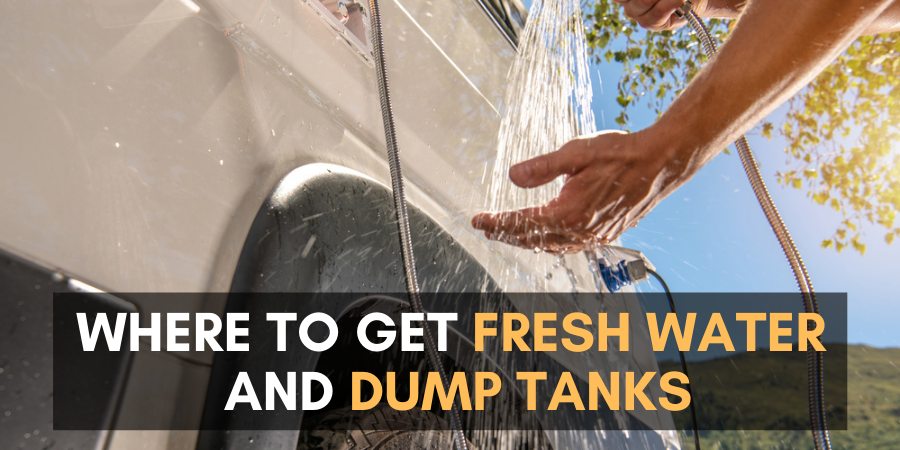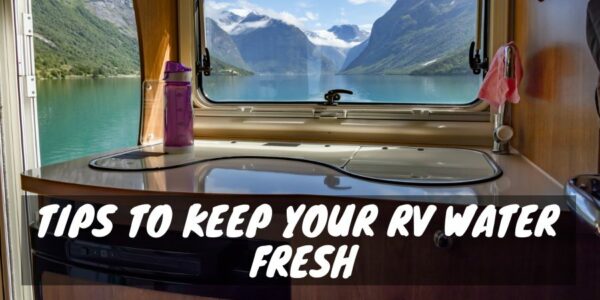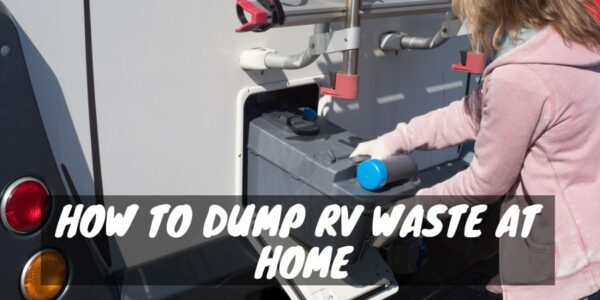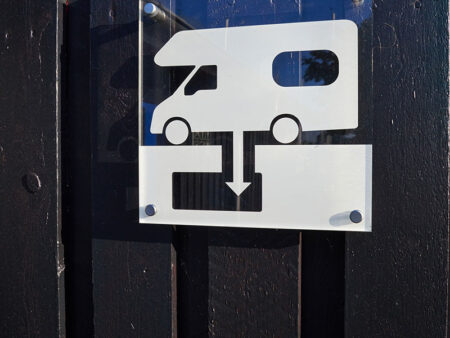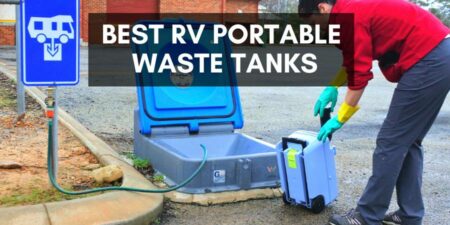Do you plan to take a long RV road trip and wonder where you can dump the waste tanks and refill your fresh water holding tank along the way?
You’re not alone in this quest. Many RVers rely on campground hookups to handle water fills and tank dumping, but there are other options.
Below, I explain all of the details for locating and using freshwater sources to fill your RV’s holding tank and places you can dump your grey and black water tanks safely, often at no charge.
When you know how to locate the RVing resources you need to keep your RV functioning, and your trip on track, the more enjoyable your travel experience will be, so stick around to find out more!
Why You Need RV Park Alternatives to Fill Water and Dump Tanks
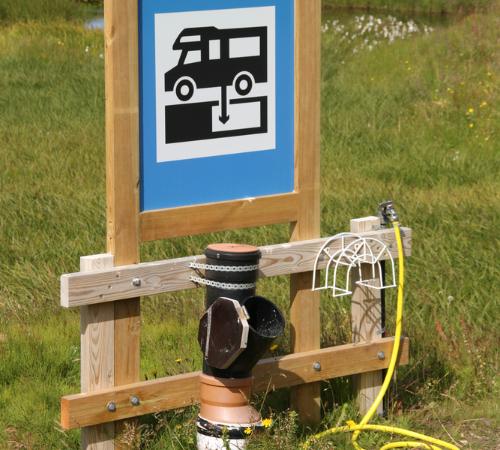
If your RV has a sink, toilet, or shower, you’ll undoubtedly have a freshwater holding tank you can use when camping off-grid or when traveling down the road.
The average RV holding tank is between 40-60 gallons, which seems like a lot, but a family can quickly use that up in a couple of days by washing up, flushing the toilet, and cleaning the dishes. Many RVs also have a water filtration system so you can drink the water from your tank.
Once you use your tank’s water, it drains to grey or black waste tanks and will need removal at a dump station.
This continual cycle of filling clean water and draining dirty water from your camper is a part of RV life, but it can become a problem if you can’t locate a place that offers clean water or a dump station when you need it.
While most RV parks allow you to bring in your RV to dump and fill, they charge anywhere from $10-$25 for the service, which can add up quickly.
Finding a convenient RV campground to stop at can also be complicated and take you way off route, wasting fuel and your precious camping time.
Another point you must consider is that water weighs just over 8 pounds per gallon, so a 40-gallon holding tank means hauling around 320 pounds of water!
Being able to fill your tank with less water during travel days and only filling up when at your destination can help you save money on fuel and overall RV maintenance costs.
While many places that offer potable freshwater RV fills also have a dump station, not every site that offers one will have the other.
You will need a safe RV water supply to brush teeth, cook food, and drink, so only use a spigot that states the water flowing from it is potable.
Many dump stations have a water hose nearby, but rarely will the water be noted as potable. The water hose is generally there for rinsing hands and sewer hoses, and you have no idea what all the people before you did with it.
I’ve seen people ram the water hose into a dirty RV sewer hose and hang it straight back on the hook. Keep that in mind before you use a dump station hose to fill up your RVs fresh water tank.
When you know all the options available to dump and fill your camper’s tanks, you’ll ensure always having a nearby place to efficiently take care of business so you can continue on your way.
To help you understand the best places to find fresh water and a dump station, check out the details below.
Tips for Filling Your RV Freshwater Tank
Before filling up your RV fresh water tank, make sure you have a proper drinking water hose to make the connection to your camper and that you never use this hose for any other task.
Cross-contamination from using the hose to rinse off your sewer connections or other RV chores can quickly lead to a holding tank full of harmful bacteria. Once this happens, you’ll need to sanitize your RV’s entire water system to make it safe again to use.
Smart RVers also know to hook an inline water filter between your camper and the spigot to ensure safe water goes into your holding tank. The filters are affordable, small, and easy to attach, so always carry a couple in your RV travel kit.
- Combo Pack of RV Fresh & Gray Water Tanks, 40 Gallon & 46 Gallon
- NSF Certified MATERIALS used for manufacturing process -- ALL PARTS of tank made with NSF International NSF/ANSI Std 61 approved...
- TANKS BUILT-IN FITTINGS: (TWO) 1.5" Balloon Style Threaded Female NPT Standard - fitting will be closed, to use remove inner...
- 40 Gallon Tank Measurements - 39 1/2" x 18" x 13" (+/- .25")
- 46 Gallon Tank Measurements - 42" x 18" x 14" (+/- .25")
Dumping Your RV Waste Tanks for Newbies
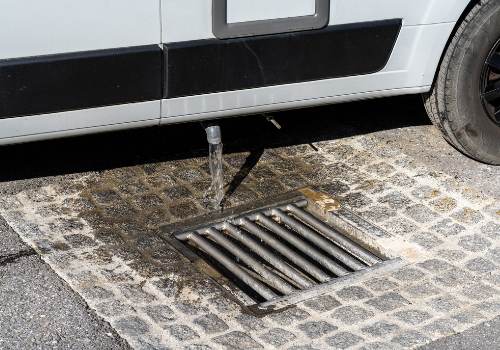
If you’re new to RVing, you may not understand the difference between wastewater tanks or ways to safeguard yourself from germs when dumping.
A grey water tank collects the soapy water that drains from your sinks and shower.
A black tank collects all the water and solid waste that you flush down your RV toilet.
Wear disposable gloves when you handle your dump station tasks and throw them away to prevent carrying germs into your camper.
Always empty your black tank first, then follow with your grey water tank to help rinse out any debris stuck in the hose.
After removing the sewer hoses and adapters from the RV, rinse them with clean water before storing them away.
Best Places to Fill Your RV Fresh Water Tank and Dump Waste Tanks
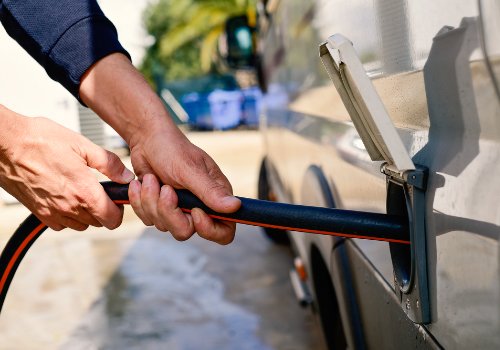
Private, State, and National Campgrounds
You can find dump stations and fresh potable water to fill your RV at any campground, but not every private campground offers non-guests the service. Always call ahead to verify if the RV park allows it, what hours you can come in, and what fee they charge.
You can use an app like The Dyrt to find nearby campgrounds along your route so you can plan a stop. Private campgrounds charge higher fees for a water fill and dump, so consider other options before forking over the money at an RV park.
If you have a boondocking vacation set up, you can always stay one night at a campground before you arrive to dump and fill tanks.
Paying the nightly rate can be worth it as you can also charge up your camper’s battery bank, take a long shower at the bathhouse, or enjoy a night’s sleep in air-conditioned comfort.
State and national parks with campgrounds have potable water filling and dump sites that you can often access without much effort. You don’t need to make a campsite reservation, but you will need to pay park entry fees if you don’t have an annual pass.
I often enter the parks with my motorhome and ask if I can “tour” the campground or park at the main lot and grab a map to scout out the water fill and dump station at the campground. I then drive over and use the facilities as most have no gate to prevent access during daylight hours.
I’ve found many parks have their water fill and dump station outside the campground just off the main park road, making using the facility even easier. I’ve never seen the water fill or dump station monitored by park staff, nor have I ever been told I can’t use it.
If you plan to camp at state and national park campgrounds often, it’s well worth the annual fees to purchase a pass so you can explore other parks along your route and use the facilities to fill or dump your tanks when necessary.
I like to keep notes of which parks I’ve been to and where their dump and fill stations are for future reference.
Forest Service Ranger Stations
Depending on where you roam in your RV, you may find potable water at ranger stations run by the Forest Service.
Search nearby locations along your route and ask a guest or ranger where the freshwater is for the campers and hikers to fill bottles or jugs.
More likely than not, the fixture is in a location you can pull your RV near enough to use your hose to fill. However, you may need to carry along a Camco Water Bandit, which makes a connection to various water dispensing pipes as not all will have the correct fitting for your filling hose.
- Extremely convenient and easy-to-use portable holding tank comprises all the essentials for the efficient and sanitary transport...
- Low drain hole guarantees that the tank empties completely; Hardware is zinc-plated to prevent rust and corrosion, ensuring...
- Ingeniously designed integrated ladder hook feature allows you to effortlessly hang the tank on your RV's ladder, optimizing...
- Skillfully constructed of high-density polyethylene HDPE material which ensures it won't leak or deteriorate even when exposed to...
- Mobility is improved with large, no-flat wheels, and the package provides a set of accessories designed to assist you in cleaning,...
Travel Centers and Truck Stops

Most gas stations, travel centers, and truck stops have a water spigot somewhere on the property you can use to refill your RV holding tank, and often you can do it for free.
Large travel centers and truck stops that welcome recreational vehicles typically offer a standard water fill and dump station and usually charge a $5-$10 fee for the service.
Places like Loves, Flying J, TA, or Pilot are great places to visit for an affordable and reliable fill and dump to refresh your RV on your travels. The Allstays app is ideal to find a spot near you that offers these amenities.
Most truck stops will locate the dump stations on the outer perimeter of the lot, so it’s easy for you to pull up any size recreational vehicle and empty your tanks.
Some truck stops will have you pre-pay inside at the register, while others have a place to pay with a credit card at the dump station. If you pay at the dumpsite, you swipe your card, and once the payment clears, it unlocks the latch over the sewer line cover so you can hook on your sewer hose and empty your tanks.
RV Dump Station Apps
Want to Connect With a Community of Over 1,078 RV Enthusiasts?
You may find it much easier to use an app to find RV dumping locations around the US. For example, SaniDumps is a popular website that tells you all the spots nearby where you can dump your grey and black tanks and usually top off your fresh water tank at the same time.
Some locations are free, while others charge a small fee. What I like about the app is all the extra details like:
- What size RVs will fit
- Whether the site is free or there is a fee
- If non-registered guests can use the facility
- If the site also offers potable water
- When it’s open
The site is continually updated by users posting new places they find and removing places that no longer offer the service.
Other sites, like Campendium, have similar lists of dump station and water fill locations.
Rest Stops
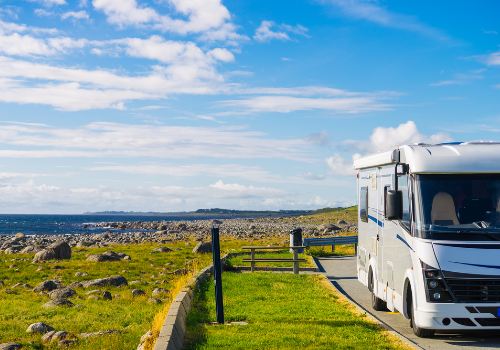
Many rest stops have spigots where you can access potable water to fill your RV tank for free.
You may need to walk around to find a close enough tap to fill your RV. Try looking around the edges of the RV and truck parking of the lot or near the picnic tables.
There are more and more rest stops or state welcome centers that now have dump stations. Most are in the Pacific Northwest, but I know some are in Mississippi and other locations, so you can completely refresh your RV for free.
Check out RVDumps.com for a map of all kinds of dump station locations, including rest stops, all over the US. The google map is dotted with color-coded locations, and a fast click on nearby spots will show you the exact address, fee range, and other pertinent information.
In my travels, I use the RVDumps map to note every stop along my route, so I’m not searching last-minute for a place to empty my waste tanks or get more water.
Cabela’s
Many RVers have no idea that most Cabela’s locations offer a dump station and potable water fill, along with RV overnight parking.
Most stores will charge you to dump your waste tanks, but I’ve never had one charge for freshwater.
Cabela’s is similar to Walmart in one aspect – go inside and purchase something to show your appreciation for the free water or overnight parking.
County Parks and Fairgrounds
County parks and official fairground locations have a stream of motorhomes and travel trailers that house workers and concessionaires for fairs and festivals, and therefore have dump stations and potable water fill spigots already in place.
You can call the county to ask about using the site if you cannot locate any information about it through online searches or apps.
Most county parks or fairground fills or dumps are free, or they charge a small fee. But, it can be hard to locate a person to direct you to the dump or water location if there isn’t an active fair or event going on.
RV Rental Companies
RV rental companies like Cruise America or El Monte RV need to have dumping and water fill stations on-site to prepare campers before and after a rental.
Most places will charge a reasonable fee, and some may let you fill or dump for free, while others can charge $25-$35 or more!
If you don’t want a shocking fee to dump your waste tanks, please call ahead to confirm if the owner allows non-renters to use the facility, what they charge if they do, and hours of operation.
Final Thoughts
When you RV, having clean water and disposing of wastewater in a safe and ecologically sound manner is crucial no matter where you plan to camp.
I hope you use the guide above to locate potable water sources and dump stations, so your RV is always fresh for the next leg of your camping adventure!
How to Find Nearby RV Dump Stations & Potable/Fresh Drinking Water (Video)
"Man cannot discover new oceans unless he has the courage to lose sight of the shore."
-- Andre Gide

